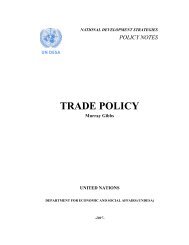Guidelines on the Safe Use of Urine and Faeces in ... - EcoSanRes
Guidelines on the Safe Use of Urine and Faeces in ... - EcoSanRes
Guidelines on the Safe Use of Urine and Faeces in ... - EcoSanRes
Create successful ePaper yourself
Turn your PDF publications into a flip-book with our unique Google optimized e-Paper software.
Carol<strong>in</strong>e Schönn<strong>in</strong>g <strong>and</strong> Thor Axel Stenström<br />
For waterborne sanitati<strong>on</strong> systems, sewage is an important potential transmissi<strong>on</strong> route when<br />
<strong>the</strong> more or less treated wastewater is discharged <strong>in</strong>to a water recipient or used <strong>on</strong> agricultural<br />
l<strong>and</strong>. Dry toilets are less likely to affect surface- or groundwater. This may still be <strong>the</strong> case if<br />
improperly c<strong>on</strong>structed or localized. For dug latr<strong>in</strong>es, like pit latr<strong>in</strong>es, problems with transport<br />
<strong>of</strong> pathogens from <strong>the</strong> excreta to groundwater have been recognized <strong>in</strong> areas with high<br />
groundwater tables, or due to soil c<strong>on</strong>diti<strong>on</strong>s favour<strong>in</strong>g microbial transport. Elevat<strong>in</strong>g <strong>the</strong> toilet<br />
<strong>and</strong> collect<strong>in</strong>g <strong>the</strong> excreta above ground as suggested <strong>in</strong> most ecological sanitati<strong>on</strong> systems<br />
can generally avoid this. Shallow pits are an <strong>in</strong>termediate alternative <strong>and</strong> limit groundwater<br />
c<strong>on</strong>tam<strong>in</strong>ati<strong>on</strong>. The c<strong>on</strong>structi<strong>on</strong> needs to account for overflow dur<strong>in</strong>g heavy ra<strong>in</strong>s that may<br />
result <strong>in</strong> run-<strong>of</strong>f to nearby surface waters. Latr<strong>in</strong>es should never be emptied <strong>in</strong> surface dra<strong>in</strong>age<br />
gutters. From a hygienic po<strong>in</strong>t <strong>of</strong> view, a sealed toilet collecti<strong>on</strong> chamber above ground is<br />
preferred.<br />
Figure 4. Material from ord<strong>in</strong>ary pit latr<strong>in</strong>es<br />
or dry latr<strong>in</strong>es should never be excavated <strong>and</strong><br />
dra<strong>in</strong>ed away <strong>in</strong> dra<strong>in</strong> gutters. Human exposure<br />
to faecal c<strong>on</strong>tam<strong>in</strong>ati<strong>on</strong> <strong>in</strong> storm-water dra<strong>in</strong>s<br />
is a major risk for transmissi<strong>on</strong> <strong>of</strong> enteric <strong>and</strong><br />
parasitic diseases.<br />
In Table 3 possible routes <strong>of</strong> human exposures <strong>and</strong> transmissi<strong>on</strong> related to dry toilets are<br />
listed al<strong>on</strong>g with some counter-measures to avoid exposures. Subsequent exposures from<br />
c<strong>on</strong>tam<strong>in</strong>ated surface- or groundwater are not accounted for here. Instead, <strong>the</strong> measures listed<br />
aim to prevent or m<strong>in</strong>imize <strong>the</strong> faecal c<strong>on</strong>tam<strong>in</strong>ati<strong>on</strong> <strong>of</strong> watercourses <strong>and</strong> <strong>the</strong> envir<strong>on</strong>ment. It<br />
is important to elim<strong>in</strong>ate pathogens as early as possible <strong>in</strong> <strong>the</strong> h<strong>and</strong>l<strong>in</strong>g cha<strong>in</strong> s<strong>in</strong>ce risks are<br />
<strong>the</strong>n m<strong>in</strong>imized <strong>in</strong> subsequent steps.<br />
Direct c<strong>on</strong>tact refers to <strong>in</strong>tended or un<strong>in</strong>tended c<strong>on</strong>tact with <strong>the</strong> excreta, e.g. touch<strong>in</strong>g <strong>the</strong><br />
material <strong>and</strong> subsequent accidental <strong>in</strong>gesti<strong>on</strong> from c<strong>on</strong>tam<strong>in</strong>ated f<strong>in</strong>gers or utensils. This may<br />
occur before treatment, dur<strong>in</strong>g treatment <strong>in</strong>clud<strong>in</strong>g h<strong>and</strong>l<strong>in</strong>g, or when <strong>the</strong> material is used/applied<br />
to soil. C<strong>on</strong>tam<strong>in</strong>ati<strong>on</strong> <strong>of</strong> foodstuffs may occur directly from use but also through unhygienic<br />
practises <strong>in</strong> <strong>the</strong> kitchen. Even if <strong>the</strong> fertilized crop will be cooked before c<strong>on</strong>sumpti<strong>on</strong>, surfaces<br />
may be c<strong>on</strong>tam<strong>in</strong>ated <strong>and</strong> pathogens transferred to o<strong>the</strong>r foods or fluids.<br />
8

















